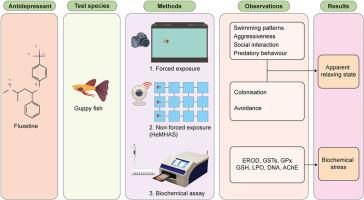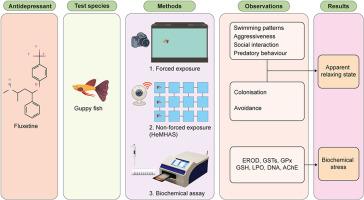氟西汀对网状刺槐的行为和生化影响:一种放松状态还是一种不明显的危机?
IF 7.3
2区 环境科学与生态学
Q1 ENVIRONMENTAL SCIENCES
引用次数: 0
摘要
氟西汀是一种抗抑郁药,用于治疗抑郁症和焦虑症。我们假设氟西汀可能对鱼类的健康产生积极影响。本研究以网状水蛭(Poecilia reticulata)为模型生物,评估了氟西汀在0.05、2.0和80 μg/L浓度下对其行为、生态和生化的影响。在行为分析方面,我们在一个新的水箱中评估了游泳模式、攻击性、社会互动和捕食行为。使用非强制HeMHAS(异质多生境测定系统)作为评估行为终点的新方法来评估回避和定植作为行为终点。生化方法基于生物转化酶活性(EROD和GST)、抗氧化防御标志物(GPx和GSH)、氧化损伤指标(LPO和DNA损伤)和神经毒性(AChE活性)。结果表明,在2 μg/L时,网纹青鱼的游动模式、攻击性和社会行为有所减少(p < 0.001),而在0.05 μg/L时,网纹青鱼在顶部和底部停留的时间差异显著(p < 0.05)。此外,暴露于氟西汀的生物需要更多的时间(显著高于2 μg/L; p < 0.001)来攻击所有作为猎物的水蚤。此外,在定植和回避实验中,网纹田鼠没有表现出定植行为(在对照室中度过的时间为50-60%),只表现出微弱的回避反应,而不是表现出嗜睡或放松状态。生化分析显示GST和LPO水平升高(p < 0.001), GPx和GSH水平降低(p < 0.05)。本文章由计算机程序翻译,如有差异,请以英文原文为准。


Behavioral and biochemical effects of fluoxetine on Poecilia reticulata: A relaxing state or an unapparent crisis?
Fluoxetine is an antidepressant used for the treatment of depression and anxiety disorders. We hypothesized that fluoxetine may positively influence the well-being of fish. We used Poecilia reticulata as a model organism and evaluated the behavioral, ecological and biochemical alterations following fluoxetine exposure at 0.05, 2.0, and 80 μg/L. For the behavioral analysis, we assessed swimming patterns, aggressiveness, social interactions and predatory behavior in a novel tank. Avoidance and colonization were evaluated as behavioral endpoints using the non-forced HeMHAS (Heterogeneous Multi-Habitat Assay System) as a novel approach to assess behavioral endpoints. The biochemical approach was based on the biotransformation enzyme activity (EROD and GST), anti-oxidative defense markers (GPx and GSH), oxidative damage indicators (LPO and DNA damage) and neurotoxicity (AChE activity). We found that the swimming patterns, aggressiveness and social behavior were reduced from 2 μg/L (p < 0.001) and the time spent by P. reticulata in the top and bottom areas differed significantly from 0.05 μg/L (p < 0.05). Additionally, organisms exposed to fluoxetine required more time (significantly from 2 μg/L; p < 0.001) to attack all the Daphnia sp. provided as prey. Further, in the colonization and avoidance tests, P. reticulata did not display colonization behavior (50–60 % time spent in the control compartment), and exhibited only weak avoidance responses, instead appearing to be either lethargic or in a relaxing state. The biochemical analysis showed that GST and LPO levels were elevated (p < 0.001), while both the GPx and GSH were reduced (p < 0.05).
求助全文
通过发布文献求助,成功后即可免费获取论文全文。
去求助
来源期刊

Environmental Pollution
环境科学-环境科学
CiteScore
16.00
自引率
6.70%
发文量
2082
审稿时长
2.9 months
期刊介绍:
Environmental Pollution is an international peer-reviewed journal that publishes high-quality research papers and review articles covering all aspects of environmental pollution and its impacts on ecosystems and human health.
Subject areas include, but are not limited to:
• Sources and occurrences of pollutants that are clearly defined and measured in environmental compartments, food and food-related items, and human bodies;
• Interlinks between contaminant exposure and biological, ecological, and human health effects, including those of climate change;
• Contaminants of emerging concerns (including but not limited to antibiotic resistant microorganisms or genes, microplastics/nanoplastics, electronic wastes, light, and noise) and/or their biological, ecological, or human health effects;
• Laboratory and field studies on the remediation/mitigation of environmental pollution via new techniques and with clear links to biological, ecological, or human health effects;
• Modeling of pollution processes, patterns, or trends that is of clear environmental and/or human health interest;
• New techniques that measure and examine environmental occurrences, transport, behavior, and effects of pollutants within the environment or the laboratory, provided that they can be clearly used to address problems within regional or global environmental compartments.
 求助内容:
求助内容: 应助结果提醒方式:
应助结果提醒方式:


